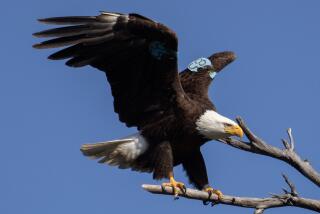Why do birds fly in a V? Endangered ibis reveals its amazing secret
Birds discovered V-formation flight long before fighter pilots did, but the exact reasons why they make these distinctive shapes in the sky has remained a mystery. Now scientists working with a critically endangered bird have discovered the avians’ remarkable secret: They surf on one another’s air currents by synchronizing their wing beats with the bird in front of them.
The findings, described in the journal Nature, reveal an exquisite in-flight precision in the northern bald ibis that could potentially prove useful for flying commercial aircraft and building bioinspired flying robots.
Many scientists have wondered what benefit birds get from flying not just in groups, but in formation. A decade-old paper in Nature, in which scientists implanted heart-rate monitors in pelicans, showed that the trailing pelicans’ hearts beat slower than the leading pelican’s – a sign that they were using less energy than the pelican in front. That’s a key survival tactic, especially for the long, dangerous, exhausting flights of migratory birds. But why would a V-shape lead to energy savings for any of the birds?
“We really wanted to see whether there really was any truth to this idea that they’re working together for a benefit,” said Steven Portugal, a biomechanist at the University of London’s Royal Veterinary College and lead researcher on the new Nature paper.
To find out, the researchers teamed up with an Austrian-based conservation group looking to save the northern bald ibis from extinction. The critically endangered species once thrived across Southern and Central Europe, the Middle East and North Africa, but its numbers in the wild have dwindled to the mere hundreds.
The conservation group, Waldrappteam, had human foster parents raise baby ibises. Once the birds were old enough, a foster parent and a pilot rode an ultralight airplane around the Alps and led the birds roughly on their natural migration from Salzburg, Austria, to southern Italy (a method used with Canada geese in the 1996 film “Fly Away Home”).
The researchers and the group outfitted 14 birds with high-tech gadgets that used GPS to log each bird’s position and used accelerometers to measure the up-and-down motion of their wings. They followed the birds for hours, and chose a seven-minute period while they were in perfect V formation to analyze.
“It sounds insane, but it took 3 1/2 weeks to get seven minutes of the top-quality, best data,” Portugal said.
It’s hard to get birds to behave exactly as you want them to, he noted – they’re living creatures, not unthinking machines.
“There was this one particular bird, called Tara, who always decided after a while that she was just going to go off and do her own thing,” Portugal said. “So you’d have this lovely V of 14 birds and she’d go, ‘I’m bored of this,’ and she’d fly off – and you’d see the poor pilot and the foster parent ... going, ‘Where are you going?’ ”
After analyzing roughly 180,000 wing flaps, the researchers found that the birds flew in formation for a reason: They placed the tips of their wings in the thin spirals of upward-flowing air streaming off each wingtip of the bird in front of them. It’s called upwash, and it looks something like a stretched-out Slinky toy.
If the trailing birds placed their wings in the leader’s upwash, it pushes them upward, and they need less energy to stay aloft. It’s the same reason that bomber planes fly in V formation, Portugal pointed out -- it often results in significant fuel savings for the trailing planes.
But the birds were doing something else as well. Unlike planes, birds flap their wings. That means that the upwash is also undulating up and down, as the lead bird’s wings do, creating a wave pattern. (It’s as if you and a friend each held an end of that Slinky and moved your arms up and down.) If the trailing bird flies a full wavelength behind, it flaps its wings in phase with its leader to match the upwash flow. But if it’s only half a wavelength behind, it flaps its wings in anti-phase – timing its flaps so that its wings will always meet that upwashing flow of air at just the right point.
“This change in behavior indicates that the ibises actively adjust their flapping wing pattern under different conditions,” University of Washington researchers Florian Muijres and Michael Dickinson wrote in a commentary on the paper.
Whether the birds are hard-wired for this kind of math or feel out the flows as they go remains unknown, Portugal said.
Either way, it requires an incredibly complex sense of coordination, scientists said. The research could one day be useful for commercial aircraft looking to fly in V formation to conserve fuel, Portugal said. It could also be useful for building birdlike robots called ornithopters and teaching them the complex rules that would allow them to work together.
ALSO:
Scientists wrestle alligators, strap cameras to their backs
Video: Fire ants’ superpowers could inspire self-healing bridgesElephant shark genome wins race for most ‘slowly evolved’ vertebrate







